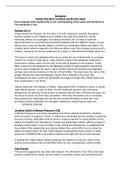Epigraphs
Hodder Education Textbook and My Own Ideas
Each epigraph adds significantly to our understanding of her ideas and intentions in
The Handmaid’s Tale.
Genesis 30:1-3
These verses from Genesis, the first book of the Old Testament, describe the jealous
Rachel’s solution to her inability to have children; she asks her husband to use her
handmaid, Bilhah, as a surrogate. According to the Bible, the 12 tribes of Israel are
descended from the sons that Jacob (patriarch) fathered with four different women; his two
official wives, Leah and Rachel (sisters), and their two handmaids, Bilhah and Zilpah. This
complex family network engenders the infamous sibling rivalry that emerges among Jacob’s
children, caused by his obvious preference for Joseph, a child that Rachel finally bears him.
This story is used by the gIleadean theocracy to justify the use of Handmaids as surrogate
mothers for couples of high status, it also reminds us that in this totalitarian dictatorship,
barrenness is always said to be the ‘fault’ of the wife as opposed to the husband. These
Bible verses form the backbone for the Gileadean system of state-regulated reproduction
and are used to legitimise the ways in which infertile women are devalued and degraded-
perhaps even dehumanised due to the loss of their fertility. They also inspir the name of the
sinister ‘Rachel and Leah Re-Education Centre’ that is featured in the novel, this
foreshadows the way in which the Handmaids are taught to accept their inferior status and
their subservience to the Wives.
Atwood noted that, the Republic of Gilead, ‘being derived from Puritanism, would, of course,
need biblical sanction. Luckily for them, the Old Testament patriarch was notoriously
polygamous; the text they chose as their cornerstone was the story of Rachel and Leah, the
two wives of Jacob, and their baby competition. When they themselves ran out of babies,
they pressed their Handmaids into service and counted the babies as their own, thus
providing a biblical justification for surrogate motherhood, should anyone need one’.
- (ATWOOD 2005:99)
Jonathan Swift’s A Modest Proposal (1729)
A Modest Proposal is a shocking, despairing and vicious satirical pamphlet by Jonathan
Swift, the author of Gulliver’s Travels, in response to the terrible poverty existing in Ireland at
the time of writing. Swift offers what he terms a modest proposal’ for saving hordes of Irish
babies and children from starvation by cooking and eating them instead, offering a range of
tempting recipe options, such as boiling, frying, baking and fricasseeing. In suggesting that
the problem of the desperately poor having children they cannot afford can be solved by
selling off surplus babies for food. Swift presents his apparently insane scheme of state-
sponsored CANNIBALISM to an implied audience that might well tae the idea seriously.
In quoting this master satirist, Atwood signposts her intention to hold up a mirror to the
serious social problems she has identified within her own contemporary cultural context.
Sulfi Proverb
This proverb suggests two key ideas that underpin The Handmaid’s Tale: firstly, that under
extreme conditions the human survival instinct is extremely strong, and secondly that the





